Siclilan Love Affair - Chef Ciccio Sultano
October, 2008 - Centurion Magazine
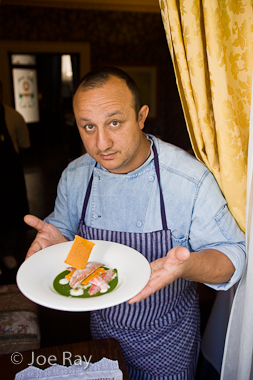
Ciccio Sultano has brought me out a tiny bowl that coddles a few forkfuls of homemade pasta bathed in almond milk and swirled artfully beneath a raw local shrimp known as a gobetto. Sweet, salty, slippery and sublime, it’s a carnal dish. “This is modern, but it’s Sicily,†clarifies Sultano “It’s like the perfect ... [insert four-letter word here].â€
For the chef, achieving this level of perfection on an island so awash in history is a balancing act that relies heavily on layers and layers of classic Sicilian contrasts: the sacred and the profane, the sweet and the bitter. These play out every day on any Sicilian street. Kids in gaudy fake designer goods swagger and strut past ancient widows dressed in black. Ferraris carrying rich businessmen flick past peasants in horse-drawn carts, clicking slowly down the street. The one-show cinema in the town of Modica plays Iron Man one day and Gomorrah the next.
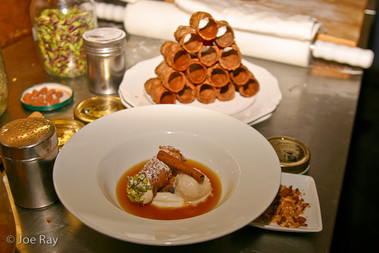 Sultano’s cannoli, a Sicilian classic, sitting atop gelato and a prickly pear sauce. Photo by Joe Ray
Sultano’s cannoli, a Sicilian classic, sitting atop gelato and a prickly pear sauce. Photo by Joe RayAbove all of these contrasts (and perhaps because of them) are art and architecture. The island’s cuisine as part of the former clashes with the thousands of years of the island’s conquests and, at their best, bring these forms to their highest levels.
Yet, if you want to mess with the heads of Sicilians, play with their preconceptions about how they prepare food. Depending on who you ask, coffee is to be heaped into a tiny, octagonal stovetop espresso pot until overflowing, long pasta (like spaghetti or fettuccini) must be dropped with a spinning motion into a large pot of heavily salted water. There are time-tested ideas about how to prepare chickpea soup, stewed meats or the bittersweet classic, caponata, a mix that includes eggplant, onions, capers and tomatoes. Grandma is usually right, after all, but this often means that, for better or for worse, the menu hasn’t changed much since she was a little girl.
Sultano the artist uses a layered approach to create his own contrasts, slowly turning Sicilian food into a modern cuisine, always using the island’s best ingredients without upsetting the Motherland’s matriarchs … at least too much.
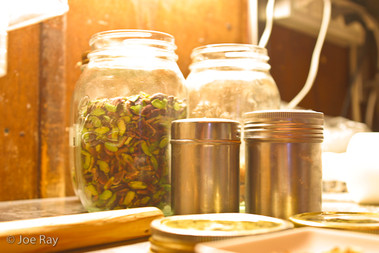 Jars of Sicilian pistachios used on Sultano’s cannoli. Photo by Joe Ray
Jars of Sicilian pistachios used on Sultano’s cannoli. Photo by Joe RayFor Sultano, this can mean pushing through some major, long-standing and historic barriers, but to listen to him and taste his food, it just makes sense. Though he may use history and time working with foreign chefs as a guide, his reliance on Sicilian products, such as olive oil, almonds and seafood is both primary and elemental, causing well-heeled clients from Ragusa Ibla and around the world to flock to his lavish dining room. This devotion even spawned a film, La Variante Sultano (‘Sultano’s Way’), a timpani-bashing ode to the island’s bounty, from the fields to the markets to the table. (A short clip can be found on the restaurant’s website, http://www.ristoranteduomo.it)
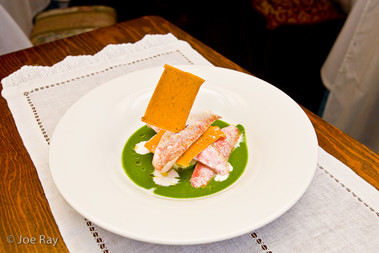 Sicilian pizza, deconstructed. Photo by Joe Ray
Sicilian pizza, deconstructed. Photo by Joe RayDepending on the season, a tasting meal might include thin slices of housesmoked grouper prosciutto wrapped around melon from the nearby town of Pachino, white wine made with zibibbo grapes that give off a ginger bread nose, a tomato sorbet that jars some sort of childhood memory and a sea urchin with lemon zest ricotta, which is not like a taste of the sea, but somehow the sea itself.
“Ragusa Ibla is quiet, it’s natural inspiration, but it’s all of Sicily that inspires me,†says the chef. “Palermo’s cuisine, Catania’s cuisine … everywhere. Sicily is very large and the mix of many domains, but I make recipes that are the story of Sicily.â€
Then Sultano’s inner Sicilian steps out a bit further. “You need the playful side and the real eating. You need to laugh and smile, but you need to eat.â€
Joe Ray
Where to eat
Il Duomo
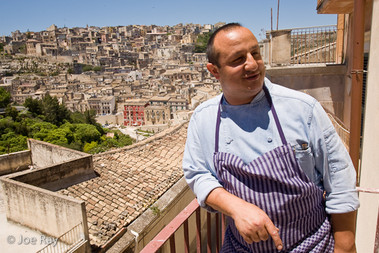 Sultano takes a break with the hills of Ragusa Ibla behind him. Photo by Joe Ray
Sultano takes a break with the hills of Ragusa Ibla behind him. Photo by Joe RayVia Capitano Bocchieri, 31
www.ristoranteduomo.it
A Sicilian splurge, Il Duomo is considered
by many to be Sicily’s best restaurant.
Put yourself in chef Ciccio Sultano’s
hands and let him guide you through
a seasonal and local menu.
Cucina Casalinga
About halfway between the towns of Modica
and Ispica, this unmarked restaurant looks
more like a bar/café from the outside (it’s
across from the Agip petrol station at a
90-degree turn in the road where SP 45
takes off toward Pozzallo), these are simple,
Sicilian home-style meals made for locals.
Try the chickpea or fava bean soup.
Where to get dessert
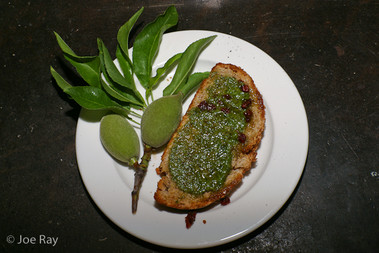 A pesto made with almonds and sprinkled with bits of sun dried tomato.
A pesto made with almonds and sprinkled with bits of sun dried tomato.
Antica Dolceria Bonajuto
Corso Umberto I°, 159
www.bonajuto.it
They had it right in The Godfather
– leave the gun, take the cannoli. And
the chocolate. Franco Ruta and his son
Pierpaolo have been making chocolate
and other delicious sweets the old
fashioned way for more than 100 years.
Caffe Sicilia
Corso Vittorio Emanuele, 125 Noto
Cheat just a little and leave the Ragusa
province for a drive to nearby Noto for
some of Sicily’s best pastries. Take
one of pastry chef Corrado Assenza’s
famous gelatos for a stroll through
this beautiful baroque town.
See the .pdf version of this story as it ran in American Express Centurion Magazine here